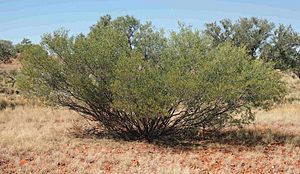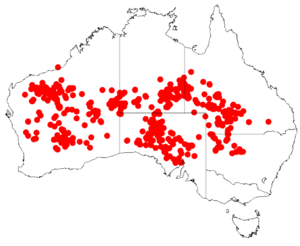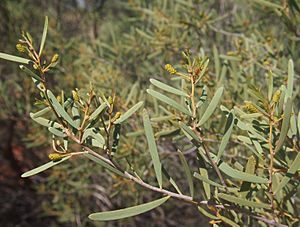Bastard mulga facts for kids
Acacia sibirica, also called the bastard mulga or false witchetty bush, is a type of tree or shrub. It's part of the Acacia family, which is a large group of plants. You can find it growing naturally in the dry, desert-like parts of Australia.
Quick facts for kids Bastard mulga |
|
|---|---|
 |
|
| Scientific classification | |
| Genus: |
Acacia
|
| Species: |
sibirica
|
 |
|
| Occurrence data from AVH | |
| Synonyms | |
|
Acacia stowardii Maiden |
|
Contents
What is Bastard Mulga?
This spreading tree or shrub usually grows up to 5 metres (16 ft) tall. It has smooth, dark grey bark that often has cracks. The plant often looks rounded or cone-shaped. It has several main stems that can be straight or crooked, spreading out from the base. Its top part, called the crown, is dense and spreads wide.
Leaves and Flowers
The leaves, called phyllodes, are slightly shiny and smooth. They are green to grey-green and can vary in shape and size. They are usually long and narrow, about 3.5 to 10 centimetres (1.4 to 3.9 in) long and 1 to 5 millimetres (0.04 to 0.20 in) wide. These leaves are tough and stand upright or spread out.
Acacia sibirica flowers between May and July, sometimes as late as September. Its flowers grow in small clusters called inflorescences. These are bright golden spikes with tiny flowers. After flowering, the plant forms flat seed pods. These pods are long and narrow, about 4 to 9 cm (1.6 to 3.5 in) long and 3 to 5 mm (0.12 to 0.20 in) wide.
How it's Different from Similar Plants
It can be tricky to tell Acacia sibirica apart from another plant called A. kempeana. The main differences are in their leaves and pods. A. kempeana usually has wider leaves (4–15 mm wide) and wider pods (8–20 mm wide). Also, the seeds inside A. kempeana's pods are placed differently.
Where Does Bastard Mulga Grow?
You can find Acacia sibirica in dry, inland areas across most of mainland Australia. It grows in all states except Victoria.
Specific Locations
In Western Australia, it grows on rocky ridges and breakaways. It likes thin, sandy soils over ironstone, basalt, or laterite rock.
In the Northern Territory, it lives in many different bioregions. These include places like Burt Plain, Central Ranges, and the Gibson Desert. It grows on rocky or gravelly hills, sandy plains, and even in sand dunes. It also thrives in areas with Mulga trees and along creek floodouts.



